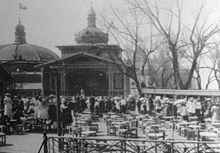Tivoli (Oslo)
The Tivoli was an area in the Norwegian capital Christiania , now Oslo, with leisure, amusement and entertainment facilities. It was built on November 4, 1877 in the Klingenberg district , in the area between the boulevard Karl Johans gate and Pipervika , and closed at the end of 1934.
history
The Tivoli in Oslo was founded by the Swedish actor and theater director Knut Tivander in 1877, but went bankrupt after two years due to the poor financial resources of the company. Thereupon the park and its facilities were taken over by the Dane Bernhard Jacobsen , who ran the Tivoli until 1898. During this time it experienced its heyday and large buildings were built for circus , theater and cabaret , open-air stages and extensive beer gardens . In winter there was an extensive ice rink in the open spaces of the Tivoli . The Tivoli had its last season in 1934. In 1937, in the course of urban development, the entire district was renovated and the entire area of the Tivoli with all its buildings demolished.
Tivoli facilities
The Tivoli consisted mainly of three large entertainment facilities: the Cirkus Verdensteater ("Circus World Theater"), the House of Chat Noir , a revue theater and the dance hall Røde Mølle (Red Mill). All buildings were closed in the spring of 1935 and demolished in 1937.
Circus Verdensteater
The Cirkus Verdensteater was a stately round building and was built from red brick in 1890 for around 300,000 Norwegian kroner . It had an inner diameter of 42 meters and a dome height of 32 meters and a floor area of around 3,200 m². The circus was used as a permanent venue for various showmen's businesses, so the Danish Circus Schumann , which was internationally known at the time, was a regular guest. The country's first cinema screening also took place here on April 6, 1896. The circus had its own band and numerous dedicated musicians and artists . Stables and ancillary buildings were located in the vicinity of the circus building. After the demolition and redesign of the site, the '' Klingenberg Kino '' was built on part of the former circus site in 1937.
Chat Noir
The Chat Noir (French for "The Black Cat") was a cabaret and revue theater founded in 1912 by Bokken Lasson . After the end of Tivoli and the demolition of the theater building in 1937, the Chat Noir moved to Klingenberggata 5, where it still exists today as a music and children's theater .
Røde Mølle
The dance hall Røde Mølle was established in 1920 and was considered the best known and most popular nightspot in Oslo in the 1920s and 1930s. The roof of the building had a stylized windmill that could be seen from afar. Its program and furnishings were inspired by the French Moulin Rouge . The guest room was arranged around a centrally located dance floor and had a stage on the side opposite the entrance. The then popular American jazz orchestra Don Parker played at the opening . In addition to numerous guest appearances by Norwegian and international musicians, the house had its own orchestra until its end. One year after the end of Tivoli in 1936, the history of Røde Mølle also ended.
Web links
- Tivoli on snl.no in the norske leksikon store
- The history of Tivoli on ude.oslo.no (Norwegian)
- Numerous views of Tivoli from the beginning to the demolition on oslobilder.no
Individual evidence
- ↑ Klingenberg on snl.no in the store norske leksikon (Norwegian), accessed on July 25, 2013
Coordinates: 59 ° 54 ′ 48.7 " N , 10 ° 44 ′ 3.7" E



